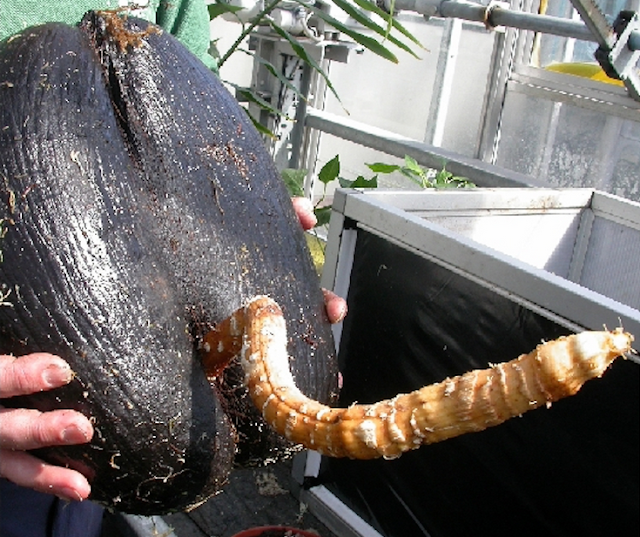The Double Coconut: The World’s Largest Seed.
Over the centuries, a giant fruit was occasionally found floating in the Indian Ocean or on the beaches of the Maldives islands. Not knowing where the nut came from, people assumed it was from some sort of giant palm tree (the fruit looks much like a huge coconut). It became known as the coco de mer (sea coconut). Since there were usually two giant seeds inside the fruit and each seed has two distinct lobes, it became known as the double coconut.
The nut’s characteristic shape (the bilobed seed looks like a pair of buttocks) gave it the name coco fesses (buttock coconut) in French. Based on nothing but the floating seed, the plant was given the botanical name Lodoicea (for King Louis XV of France) maldivica (for its presumed home under the sea near the Maldives). An alternate name was Lodoicea callipyge, the latter name meaning “beautiful buttocks.” It’s the only palm in the genus Lodoicea.
The French explorer Marc-Joseph Marion du Fresne finally discovered the origin of the giant seeds when he visited the Seychelles Islands, at that time uninhabited, in 1768. Rather than coming from an undersea tree, they grew on a huge terrestrial palm up to 112 feet tall (one specimen attained 186 feet in height). The giant fronds are up to 33 feet in diameter. The leaves are designed to trap rain like a funnel and carry it to the palm’s roots.
The seeds are enormous, 16 to 20 inches long, and can weigh up to 40 pounds, about the weight of a 4-year-old. They can take up to 7 years to mature on the palm and 2 years to germinate once they reach the ground. Oddly enough for a seed first found floating on the open waves, healthy, mature double coconut seeds aren’t buoyant: they have to be partially rotted to be able to float.
Preserved seeds are often seen in scientific displays and botanical gardens, but the double coconut palm produces so few seeds that their harvest is now controlled by CITES, meaning they can only be harvested and sold with the proper permits. Plus, the species itself is considered endangered and therefore theoretically fully protected in its native country (the Seychelles) where its population is down to only a few groves on two separate islands (although it is being introduced or reintroduced to other islands).
Protected or not, an illegal trade in double coconut nuts still flourishes, with stolen ones being sent to China where thin slices are sold at outrageous prices as an aphrodisiac.
In tropical climates, you’ll find double coconuts growing in many botanical gardens, but there is almost always only one lone specimen. I’ve run into a handful over the years in my travels. However, garden-grown palms rarely produce seed, as the species is dioecious, that means it produces male and female flowers on separate plants.
Even if you did plant two specimens of this gigantic palm and were lucky enough to end up with one plant of each sex, it still takes 80 to 100 years to reach blooming size. (So much for your plans at running a double coconut nursery!)
Fresh double coconut nuts are available commercially on a very limited basis and are extremely expensive (up to $300 per nut). www.rarepalmseeds.com offers some occasionally on a first come, first served basis. Still, there aren’t many gardeners who have the budget, the patience and the space to grow this unusual palm.
And to complicate matters, the nut produces a long, tuberous “sinker” (modified cotyledon) up to 6 to 12 feet long that travels over the ground, “looking” for an appropriate spot for future growth. It then sinks into the ground and a green leaf eventually emerges from that spot. This may be a great strategy for a heavy fruit that doesn’t roll well and will likely therefore start to sprout in the mother plant’s dense shade. Then the sinker can lead off in the sunniest direction so the baby plant sprouts where light is most available. It can be very hard to control just where to sinker will decide to sprout when you grow it in a pot!
Also, if your winters involve even a hint of frost, this is not going to be a good choice for you: it is truly a tropical palm, intolerant of temperatures below 65?F. Nor would any normal human have the space and the conditions for one indoors.
The double coconut: curious, gigantic, historic, even mythic and definitely worth looking for in botanical gardens, but not really the kind of living souvenir you’d be able to bring home and grow for yourself.








No comments:
Post a Comment